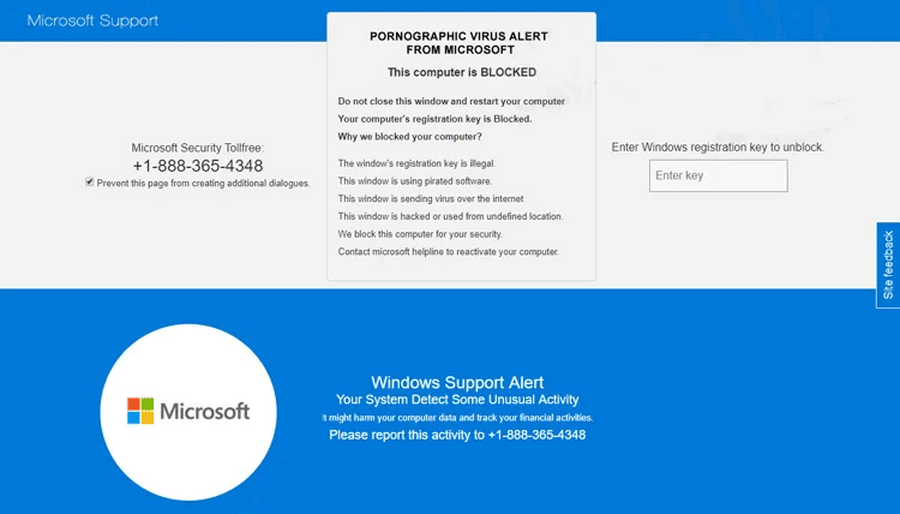Microsoft shows you the banner which states that your PC is infected with a “Pornographic virus”? It seems that someone wants to involve you in a popular online tech support scam1, called “Pornographic virus alert from Microsoft”. But how can they do it with a single banner? That article will show you the whole mechanism and will also explain why this notification appears so obsessively.
Pornographic virus alert from Microsoft: how it works and why is it malicious?
Once upon a time, after opening the browser, you may see the banner which says that your PC is infected with awful viruses. As you can suppose by the name of this alert, it also states that this virus got on your PC from pornographic websites. To eliminate this malware, “Microsoft” offers you to contact their support by the number they specified in the text. As they assure you, you cannot fix your computer without calling support. And here is the first suspicious element – times when the viruses may get into the PC exactly after opening the website are gone. It was possible at the beginning of the ’00s when the browsers were raw and had a huge amount of vulnerabilities. One of these security breaches allowed to start of file downloads and installations without the user allowance. But hold on, here are more interesting moments.

Calling the support as a sign of the malevolency of this banner
First thing is the number this banner offers as an official Microsoft helpline to reactivate your Windows. It is completely different from the one which is published on the Microsoft website. When you call this number, you will hear a “support” that will offer you to grant him remote access to your PC. Sometimes, such action is needed – when some of the program components are working wrong on the specific PC configuration. But when we are talking about the viruses, which are already detected (as the banner says), the need for a remote connection to your PC is very questionable.
Finally, things are getting really ridiculous. The support checks your PC and then says that you really have a lot of viruses. To remove them, you need to install a perfect solution they can offer you only today – an unknown (or low-trusted) antivirus. They can send you a link or even install it themselves, using the remote control. Installing the unknown software was never a pleasant experience. And all these strange moments surely show that this thing is not one you can trust. Usually, the program this “support” offers you is an example of typical scareware. This sort of program mimics the antivirus app and shows you tons of false detections.
The total possible danger of pornographic virus alert from Microsoft
Let’s count. The first danger the user carries is remote access. The user who gets the ability to manage your PC can do everything literally – delete your files, modify your settings, install any programs from any sources – he is a king now. Granting remote access must always be well-weighted because of the dangers it carries. Nonetheless, a lot of users ignore that security rule and give access to anyone who offers help.
Moving on. Scareware may look like a considerably non-dangerous but annoying app. But let this app stay active in your system for about 30 minutes, and you will not be able to use the PC as usual. Because of its malevolent nature, this unwanted program randomly blocks the elements of important applications. Hence, you can’t use the program as usual. To remove these “malicious and vulnerable items”, you need to purchase the full version of this pseudo-antivirus. Moreover, you can’t uninstall a program as usual – through the application list. Manual removal or antimalware software usage is the only option.

Danger #0. Source malware.
And the last one, which must be the first. I have missed mentioning the initiator of that event – adware. The pornographic virus alert from Microsoft cannot appear independently on your PC. Access to this page will just be blocked by the web browser you use. So, it is quite easy to conclude that something changed your browser configuration and networking settings to show you this banner every time you open your web browser. Adware is a kind of virus that usually does the same, that’s why I supposed it’s present. The way you get this virus on your PC may be different, and you can read the removal guide in that post. Fortunately, the adware can easily be removed with anti-malware software.
The thing you can do to get rid of the banner at the moment is to close the browser window or reboot the PC. Radical ways, but pretty effective against this sort of scam. Usually, that banner does not have any “close” buttons at the top right corner. Don’t worry – the notifications that “Microsoft locked this computer” are 100% lies. Still, neither viruses nor companies can block the computer through the Chrome browser. To prevent the browser appearance it is better to avoid using dubious sites. Things like torrent trackers or sites for YouTube videos downloading may redirect you to other pages, and this nasty thing is just among them.
- Example of another widespread online scam.


